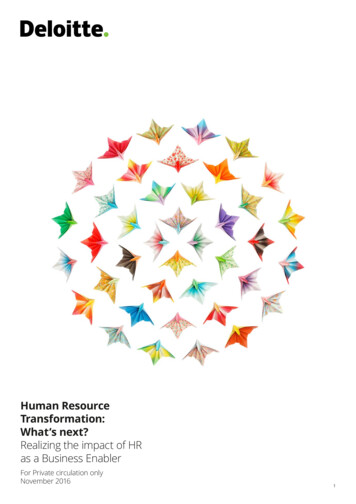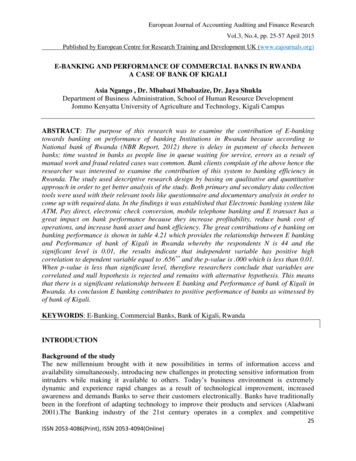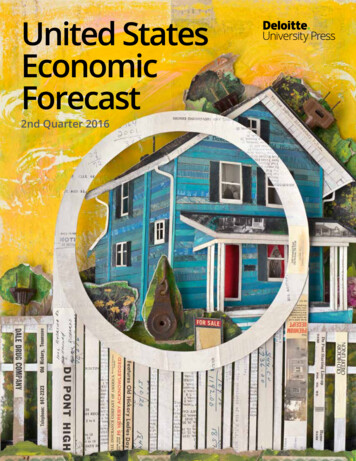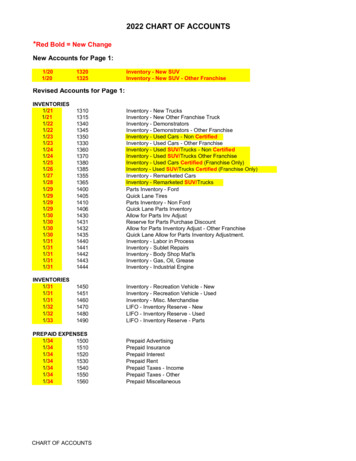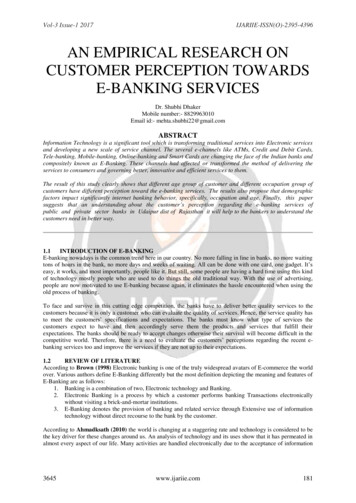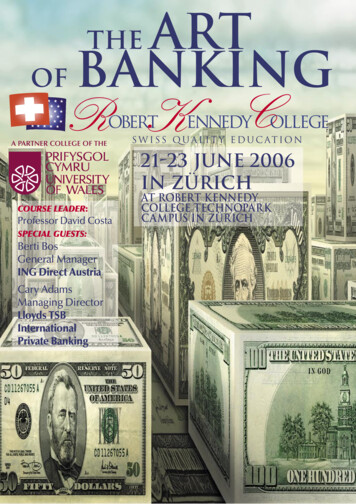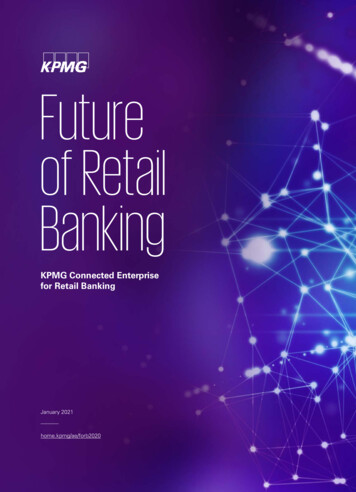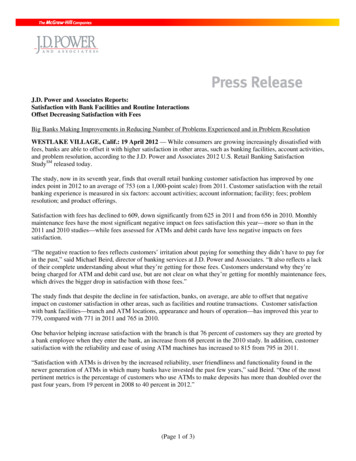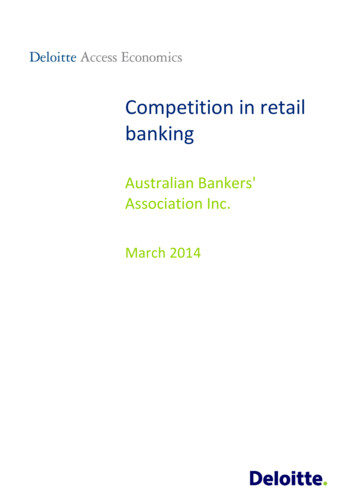
Transcription
Competition in retailbankingAustralian Bankers'Association Inc.March 2014
Competition in retail bankingContentsGlossary . iExecutive Summary. i1Introduction . 12The role of competition . 33452.1Consumer welfare . 32.2The stability/efficiency trade-off . 4Competition in retail banking in Australia . 73.13.2Differing business models . 7The cost of funds. 133.3Bank profits . 20Preliminary evidence of competition in retail banking . 244.1Defining markets. 244.2Concentration ratios . 25Dynamics of competition . 295.15.25.3Barriers to entry . 29Availability of substitutes . 34Innovation and product differentiation . 375.45.5Implications for consumers . 40Looking to the future . 45Conclusions. 47References . 48Appendix A : Concentration ratios . 55Appendix B ACCC merger assessment criteria . 61Appendix C Data sources . 63Liability limited by a scheme approved under Professional Standards Legislation.Deloitte refers to one or more of Deloitte Touche Tohmatsu Limited, a UK private company limited by guarantee, and its networkof member firms, each of which is a legally separate and independent entity.Please see www.deloitte.com/au/about for a detailed description of the legal structure of Deloitte Touche Tohmatsu Limited andits member firms. 2014 Deloitte Access Economics Pty Ltd
ChartsChart 3.1 : Funding composition of banks in Australia – share of total funding . 14Chart 3.2 : Securitised issuance, Australia, 1994-2013 . 16Chart 3.3 : Australian RMBS new issue and revaluation margins . 16Chart 3.4 : Interest rate spreads on savings accounts and term deposits . 17Chart 3.5 : Average term deposit rates ( 10,000 30-day) . 18Chart 3.6 : Banks’ net interest margins (domestic operations; half-yearly) . 19Chart 3.7 : The top 50 companies (by market capitalisation) RoE for 2013. 22Chart 5.1 Number of ADIs, 2004-2013 . 30Chart 5.2 : ATM access . 33Chart 5.3 : Transaction account switching (%), Australia . 36Chart 5.4 : Use of banking services, 2011 (population 15) . 42Chart 5.5 : Use of cards, 2011 (population 15) . 43Chart 5.6 : Net interest margins of major banks, 2007-2012 . 44Chart 5.7 : Domestic banking fee income from households . 45Chart A.1 : Market shares in transaction accounts based on value, 2013 . 56Chart A.2 : Market shares in interest-bearing accounts based on value, 2013 . 57Chart A.3 : Market shares in housing loans based on value, 2013 . 58Chart A.4 :Market shares in other household loans based on value, banks only, 2013 . 59Chart A.6 : Market shares in other credit card loans based on value, banks only, 2013 . 60TablesTable 3.1 : After-tax return on equity (%) . 21Table 3.2 : Pre-tax profitability of major banks (% of total assets). 22Table 4.1 : Concentration ratios (banks only). 26Table 4.2 : Bank concentration in the European Union (HHIs), 2007-2011 . 27Table A.1 : Transaction account concentration ratios (banks only) . 56Table A.2 : Interest-bearing savings account concentration ratios (banks only) . 57Table A.3 : Mortgage concentration ratios (banks only). 58Table A.4 : Personal loan concentration ratios (banks only) . 59Table A.5 : Credit card concentration ratios (banks only) . 60Table C.1 : Data sources . 63
FiguresFigure 5.1 : Customer experience index by country, 2013 . 41
Competition in retail bankingGlossaryABAAustralian Bankers’ AssociationABACUSAssociation of Building Societies and Credit UnionsACCCAustralian Competition and Consumer CommissionADIAuthorised deposit-taking institutionAFRAustralian Financial ReviewAPRAAustralian Prudential Regulation AuthorityATMAutomatic Teller MachineBBSWBank Bill Swap RateBISBank for International SettlementsCIECentre for International EconomicsCOBACustomer Owned Banking AssociationCRConcentration ratioCUBSCredit unions and building societiesDAEDeloitte Access EconomicsGDPGross Domestic ProductGFCGlobal Financial CrisisHHIHerfindahl-Hirschman IndexNFCNear-Field CommunicationsNIMNet interest marginOECDOrganisation for Economic Co-operation and DevelopmentRBAReserve Bank of AustraliaRMBSResidential mortgage backed securitiesSMHSydney Morning HeraldDeloitte Access Economics
Executive SummaryThe Australian economy has prospered over the last quarter of a century. In part, this canbe attributed to the robustness and competitiveness of its financial system. Both of thesefactors have contributed towards improving consumer welfare.The Global Financial Crisis (GFC) recently has disrupted the financial system, including retailbanking. In particular, it has led to changes in the dynamics that influence the competitiveenvironment arising from two main areas: international institutions adopting less aggressive strategies or withdrawing from theAustralian banking industry as a result of developments overseas; and deterioration of securitisation markets, both in price and volume.The GFC led to: a more risk-averse approach by investors, bankers and regulators; and some consolidation in retail banking through withdrawals, mergers and acquisitions.Against this background, the Australian Bankers’ Association (ABA) has commissionedDeloitte Access Economics (DAE) to undertake an independent review of the state ofcompetition in the Australian retail banking sector (defined in this report as individualconsumer’s banking, excluding small business and farmers). If competition is operating well,this will deliver benefits to consumers and the economy more broadly, as it will driveefficiencies, lower prices and encourage innovation and choice.There can be a trade-off between efficiency and stability. Policy makers have focused onsupporting stability in recent years. There is now an opportunity for policy makers toconsider whether competition could be improved further without undermining stability orcreating distortions which have an adverse impact on the efficient functioning of thesystem.Competition can take many forms. Financial institutions compete through many differentmeans. Different business models will prevail in the market at various times, reflecting theirstrengths and weaknesses. As long as conditions allow different models to proliferate, therewill be a competitive environment. For example, financial institutions of different sizes willhave different advantages that allow them to compete effectively against each other.The cost of funds is an important determinant of an organisation’s ability to pricecompetitively. Large banks have an advantage in securing funds in a cost effective manneras their credit ratings are higher than small banks on a stand-alone basis, and their ratingsalso benefit because they are deemed ‘systemically important’ and, as such, are believed tobe more likely to receive government support in times of stress (Standard & Poors, 2012).However, there are differing views as to whether a systemically important bank wouldreceive government support.The reported profits of the major domestic banks have raised concerns about theeffectiveness of competition in the sector. The performance of Australian banks since theGFC and global economic downturn has highlighted that they are well managed, and notexcessively profitable.Deloitte Access Economicsi
“Our assessment is that, if you look at the rates of return on equity in our banksover a lengthy period of time, say 20 years, they are good but they are actuallybroadly in line with the listed company sector in general in Australia. I do notthink it is obvious from that comparison that they are in some sense excessivelyprofitable.”RBA Governor Glenn Stevens, 2012There are a range of measures of competition. Guided by the Australian Competition andConsumer Commission (ACCC) merger assessment guidelines, we consider:Market concentration: In transaction accounts, interest-bearing accounts, mortgages,personal loans and credit cards, the concentration ratios do not exceed ACCC thresholds.Thus, the level of concentration does not indicate any problems with competition despitethe increase in concentration since the GFC.Barriers to entry: Technology and globalisation have worked together to reduce thebarriers to entry in all areas of retail banking in recent years, and are set to continue to doso in the future. Technology has reduced distribution costs, allowing low cost players toenter. Globalisation and policy changes have allowed overseas banks and non-banks toenter and compete aggressively.However, some submissions to recent government inquiries have cited concerns thatregulatory barriers could limit the level of competition in the market.Availability of substitutes: There is a wide variety of products and suppliers in theAustralian retail banking market. Recent policy changes and technology have made it easierto switch, both for individual products or bundles of products.“In the more subdued post‐GFC credit environment, competition remains keenand considerable switching is occurring.”Fraser, 2011Innovation and product differentiation: Innovation in retail banking has taken a number offorms including using different distribution channels, different sources of funds and productinnovation. Innovation has come from all parts of the markets. Along with the mainincumbents, this has included, for example, innovation from non-ADI home lenders usingcapital markets to source funds, global banks using online distribution channels or nonfinancial institutions using technology to provide customers with new ways to accessfinancial services (such as brokers or co-branding credit cards).Implications for consumersCompared to overseas, Australians are well served by their retail banking system.Australians have some of the highest levels of access to banking services and customersatisfaction in the world: over 99% of Australians have an account at a formal financial institution; Australia’s banking system is one of the five least-risky in the world (Liondis, 2014);andDeloitte Access Economicsii
Australian banks rank fourth in the world in providing a positive customer experience(Capgemini and Efma, 2013)Looking to the futureBased on the assessments of the level of concentration and market dynamics surveyed inthis report, it can be concluded that there is no basis for serious concern about the level ofcompetition in retail banking markets.There will however be more benefits for consumers if more competition returns to themarket. This can be expected as global markets and suppliers of funding continue torecover from the GFC. To date, the pace of this has been slower than expected and theextent of the recovery remains unclear. This has made it difficult for some participants,including those that have made extensive use of capital markets to fund their lending, toinnovate and compete.Yet, overall, the Australian banking system remains stable and competitive. Consequently,while it is appropriate for policy makers to review the competitive landscape, Australianconsumers still have a very robust banking system by world standards, which continue toadd to consumer welfare. This is illustrated by the ability of participants throughout theindustry to develop and promptly adopt solutions using new technologies across the suiteof retail banking products.Deloitte Access Economicsiii
1 IntroductionAustralia has prospered economically over the last quarter of a century. In a large part, thiscan be attributed to its robust and competitive financial system. Both of these factors haveincreased consumer welfare through improved efficiency and innovative products.The retail banking industry in Australia is characterised by close competition between themajor banks. Since the 1980s, competition has been further bolstered by smaller firmsexerting significant competitive pressures.Barriers to entry decreased following the financial deregulation of the 1980s andtechnological growth through the 1990s. This process allowed other authorised deposittaking institutions (ADIs), foreign banks and niche players to more readily enter the retailmarket. Their competitiveness was also supported by the introduction and growth of newsources of funding – in particular, securitisation – through the 1980s and early 1990s(Australian Prudential Regulation Authority (APRA), 2000).Competition within the sector led to positive outcomes for customers, including: more innovative product offerings and delivery channels; better value for money, as evidenced by decreasing net-interest margins from the1980s through to the mid-2000s; improved access to credit, especially for groups such as first-home buyers and theself-employed; provision of no-cost and low-cost basic bank accounts; and extensive choice of products and providers.The Global Financial Crisis (GFC) has disrupted the financial system, including retail banking.In particular, it has led to changes in the dynamics that influence the competitiveenvironment arising from two main areas: international institutions adopting less aggressive strategies or withdrawing from theAustralian banking industry as a result of developments overseas; and deterioration of securitisation markets, both in price and volume.The GFC led to: a more risk-averse approach by investors, bankers and regulators; and some consolidation in retail banking through withdrawals, mergers and acquisitions.Issues in global markets continue to have significant effects. Australian banks have beenfaced with some sources of funding being less available, and being offered at higher costs.In addition to intensified risk management, this has forced banks to restructure theirfunding arrangements and increased competition for deposits (Senate EconomicsReferences Committee, 2012). Higher funding costs have made it more difficult for playerswithout sizeable balance sheets and/or strong reputations to compete as vigorously asbefore. These tightened conditions have led to consolidation within the market and thewithdrawal of some players.Deloitte Access Economics1
There is still close competition between the major banks. This is evident through the speedof their competitive response to price changes and technological developments (seeSection 3.1). Other product markets and suppliers of funding have begun the process ofrecovery from the GFC. However, the pace of this has been slower than expected and theextent of the recovery remains unclear. This has led to discussion of whether regulatoryintervention should be considered to enhance competition across the industry. In responseto public concerns, the Government introduced the Competitive and Sustainable BankingSystem Package.To assist public understanding of the level of competition that currently exists, the ABA hasasked DAE to prepare a report examining the level of competition in retail banking inAustralia. This report is not intended to serve as a comprehensive analysis. Rather, itconsiders key issues at a high level.The report proceeds as follows. Chapter 2 discusses competition in the primary productmarkets in retail banking, as well as trends in competition in the retail banking sector moregenerally. It also explains that competitiveness is not the only important consideration for afinancial system. It briefly discusses the importance of stability, and evidence on the tradeoff between the two factors.Chapter 3 explores the context of the retail banking sector in Australia. It considers some ofthe key trends which have shaped the industry in recent years. This includes discussion ofchanges in the cost of funds, and the extent to which this impacted on different parts of theindustry. It discusses the profitability of Australian banks relative to those overseas and toother domestic industries.Chapter 4 outlines the approach used by the Australian Competition and ConsumerCommission (ACCC) to assess competition. It defines the relevant markets for retail bankingproducts, and calculates concentration ratios, which are used as an initial indicator of thelevel of competition in the market. These are compared with other jurisdictions.Chapter 5 contains a more detailed analysis of the most significant factors which contributeto the level of competition in retail banking. It concludes by discussing the value that thecurrent system creates for consumers. Finally, it considers how competitive dynamics arelikely to evolve in the future.Deloitte Access Economics2
2 The role of competitionCompetition is an important characteristic of a market, and drives better outcomes forconsumers, such as lower prices and more choice. Competition for market share in retailbanking, including from non-banks, improves consumer welfare through lower prices, morechoice, better products and improved quality and access to services.In the long term, consumer benefits are also crucially dependent on a stable and robustfinancial system.2.1 Consumer welfareCompetition between suppliers is important to outcomes for consumers. The morecompetitive a market is, the more value producers must offer in order to attractconsumers. These offerings can take a range of forms. In retail banking, this leads to arange of benefits:“The Committee believes competition is good. It should result in intermediationservices being provided at low cost, finance being directed to where it can bebest used and consumers and small business being able to access it on fairterms.”Senate Economics Committee, 2011.One of the ways in which producers seek to attract customers in a competitive market isthrough lower prices. By offering a similar product for a lower price, suppliers enticeconsumers to switch away from their existing provider. The ability to purchase the samegoods for less has clear benefits for consumers. For example, in interest-bearing savingsaccounts, a depositor would benefit from being offered higher interest rates.However, the willingness of customers to switch will depend on how sensitive they are tochanges in price. In banking, consumers might be less willing to move to capture any gainsbecause of the inconvenience of changing institutions. Their decision will also be influencedby switching costs. These issues are discussed in more detail in Section 5.2.A competitive market offers consumers more choices. There are more suppliers and/orproducts available, allowing individuals to be more discerning and choose the productswhich are most appropriate to their needs. This is important in retail banking where somefeatures are more important to some consumers than others. For instance, branchnetworks are important to some consumers, while others value comprehensive digitalofferings more highly.Competition also encourages innovation to retail existing customers and attract new ones.In a more competitive market, producers have more incentive to innovate. It provides themwith the opportunity to differentiate their products, thus attracting a greater market share.This has benefits for consumers. Innovative products could be more convenient, cheaperand/or easier to use, thus creating more value. For example, recent competition in theDeloitte Access Economics3
industry has led to the development of products such as mobile banking which increaseaccessibility and convenience for customers.In retail banking, competition has also facilitated consumer access to financial services. Inmodern society, access to services can be very important. It can affect an individual’s abilityto purchase goods and services, access credit and even obtain employment. However, giventhe risks associated with some retail banking products, institutions may prefer not toprovide products to all potential customers. Those who are least likely to be granted accessto products are often the ones who are most disadvantaged.Competition can drive wider accessibility, as well as industry and individual institutions’financial literacy initiatives. Institutions may seek to increase their market share by offeringtheir services to a broader group of individuals. This can benefit those who are given accesswhich they would not have otherwise been granted. For example, competition andinnovation led to the creation of low-doc loans. This enabled more self-employed would-behomeowners to procure mortgages.Competition is important. Ultimately, however, a market should be assessedby the level of benefits which flow to its users and consumers.2.2 The stability/efficiency trade-offAs part of the broader financial system, stability is another desirable feature of retailbanking. Ensuring the industry’s overall stability is a key social and policy objective. Theadverse consequences of financial instability to the wider economy were demonstratedthrough the GFC. As a result, stability has become a focal point for regulation at theexpense of competition. However, there can be a trade-off between stability andcompetition.There is broad agreement among competition agencies from OECD countriesthat the purpose of competition policy is to protect competition, notcompetitors.Organisation for Economic Co-operation and Development (OECD), 2011Financial stability also is a key consideration for policy makers, especially in the wake of theGFC. Ian MacFarlane explained:“To some, the word 'stability' sounds unexciting, and probably more so if I usethe term 'economic stability'. But stability is not just an economic concept; ithas a profound impact on the lives of people. Instability can create havoc,damage institutions, and leave a legacy from which some families and nationswill take many years to recover.”MacFarlane, 2006Australia experienced considerably less financial instability than many countries in the GFC.Other factors – such as the Asian boom – played a part in this. The costs of financialinstability ranged from triggering recessions to undermining confidence in the financialsystem. In the United States, for example, the GFC triggered a recession in which grossdomestic product (GDP) fell 6%, and the unemployment rate almost doubled to 10.1%Deloitte Access Economics4
during the crisis. The Federal Reserve Bank of Dallas estimated that the GFC cost theAmerican economy between 6- 14 trillion and 40-90% of 2007 US output (Sheng, 2013). In2013, despite economic recovery, actual GDP still was 4.6% lower than potential GDP(Center on Budget and Policy Priorities, 2014).The research on the trade-off between these two characteristics can be distilled to: too much competition “reduces bank charter values and may increase incentives totake risks”. This does not imply, however, that low levels of competition arenecessarily ideal – it “leads to inefficiencies and may add to the too-big-to-failproblem” (Ratnovski, 2013).These two effects are reconciled at an “optimal” level of competition from a stabilityperspective. This occurs at a point where market concentration is neither too high nor toolow.The trade-off between competition and stability was summarised by the OECD:“Competition and stability can co-exist in the financial sector the results ofempirical studies linking competition and stability are ambiguous, however.Structural and non-structural measures of competition are found to be bothpositively and negatively associated with financial stability, depending on thecountry and the sample analysed and the measure of financial stability used.”OECD, 2011The retail banking industry in Australia has been subject to several shocks over recent years– in particular, the Asian Financial Crisis, GFC and the post-GFC effects. Despite this, thesystem has been praised for its overall resilience. This can be attributed to a number offactors: Australian banks are well managed, however, banking policy and strict prudentialregulation have clearly played an important part.There is general consensus that the regulatory focus on stability during the GFC was wellfounded and in the interests of the general population. However, with the crisis havingpassed (even if some of the effects linger), it is appropriate that this focus should be reevaluated.According to the Senate Economics Committee’s Inquiry in to Competition within theAustralian banking sector:The Australian Government, like those overseas, placed greater emphasis onstability than competition during this period. As the effects of the GFC pass, andregulators respond to the lessons learned from it, competition has heated upfor deposits but not yet for loans. The Committee believes the time has come toagain place more emphasis on boosting competition allowing the benefits ofcompetition to emerge without such a loss of stability is the role of theauthorities.”Senate Economics Reference Committee, 2011Deloitte Access Economics5
The OECD’s report on Competition in Retail Banking and Financial Stability had this to say:Encouraging new entry may therefore be better achieved in the longer run byreducing regulatory barriers: for example, by removing unnecessarily anticompetitive regulation and making the entry process as easy and inexpensiveas possible, especially in markets where mega mergers have been allowed asan emergency measure.OECD, 2011There can be a trade-off between efficiency and stability. Policy makers havefocused on supporting stability in recent years. Post-GFC, there is anopportunity for policy makers to consider how to support competition. Thechallenge is to improve competition without undermining stability or creatingdistortions which have an adverse impact on the efficient functioning of thesystem.Deloitte Access Economics6
3 Competition in retail banking inAustraliaThis chapter places the analysis of the current level of competition in retail banking inAustralia in context.Competition within an industry can take a number of forms. At a base level, firms competein two ways – product and price. However, the exact nature and focus of this competitionvaries between industries. In retail banking, context is provided by examining businessmodels, cost of funds and profitability.3.1 Differing business modelsIn retail banking, competition to attract customers occurs through a number of means: price; product features; quality and access to services; innovative product offerings; and branding.Between the larger banks, prices (i.e. interest rates, fees and charges) tend t
ABACUS Association of Building Societies and Credit Unions ACCC Australian Competition and Consumer Commission ADI Authorised deposit-taking institution AFR Australian Financial Review APRA Australian Prudential Regulation Authority ATM Automatic Teller Machine BBSW Bank Bill Swap Rate BIS Bank for International Settlements

